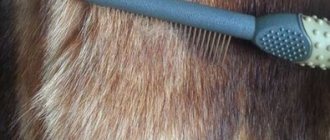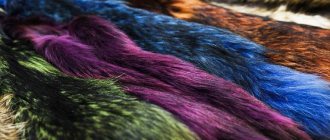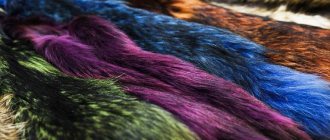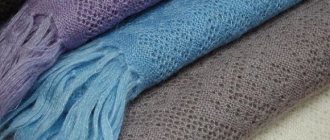09.26.2016 Category: Just interestingAuthor: Natalya Ivantsova
A fur coat is not only protection from the cold, but also part of the image, giving special status to its owner. When buying a fur coat or coat, you expect to wear the item for several seasons. But if you store your fur coat incorrectly in the warm season, it will hardly last you two seasons. Therefore, it is important to know about all the intricacies of fur care.
- How to prepare a fur coat for summer?
A few secrets before sending your fur coat on vacation - video
- Mouton fur coat
- Creases
Features of storing fur items
Every woman wants her fur coat to retain its beautiful appearance for a long time.
Any woman knows that fur coats can be made of natural and artificial fur. If you are the happy owner of a mink, arctic fox or sable, then be sure to take care of the issue of storing your treasure during the warm season. The fact is that with rising temperatures, excessive air humidity, and poor ventilation, natural fur can:
- turn yellow;
- lose your shine;
- become brittle;
- turn into food for moths.
Under particularly unfavorable circumstances, bald spots may appear on things. By the way, all these environmental factors are completely safe for fur coats made of synthetic fibers.
Special conditions are a whim for an artificial one, but a severe necessity for a mink coat.
You can keep your fur coat in perfect condition only if certain conditions are met.
When buying an expensive coat or fur coat, you want to be irresistible and do not allow the thought that such clothing may become unusable. To prevent this from happening, it is necessary to create special storage conditions. Under the influence of various factors, such as increased air temperature, humidity or poor ventilation, natural fur can fade, turn yellow, lose wear resistance and become brittle . Hair may fall out, forming bald spots on clothing.
Advice!
But this, as a rule, does not apply to artificial material. A fur coat made of synthetic fibers is not afraid of sunlight, changes in temperature and humidity, and is also not of interest to moths.
How to prepare a fur coat for summer?
Before sending your fur coat on summer vacation, it needs to be cleaned.
You can recognize natural mink fur by the length of the hairs. This animal has them exactly the same! It is due to this feature that mink products are particularly velvety.
Before you send your fur coat “on vacation”, it needs to be prepared.
1. We examine the item from the outside and from the inside out. If necessary, we strengthen the buttons and sew up the holes in the lining.
2. Remove stains. To do this, you can go in two ways: go to dry cleaning (the best option, especially if there are a lot of stains) or try to deal with the stains at home. The best way to remove greasy marks is to mix 9% vinegar and vodka in a 1:1 ratio:
- Wet the sponge with the solution.
- We wipe away the stains. If the fur coat has a short pile, the movements should be “against the grain”, while for long-haired ones we iron it, on the contrary, in the direction of the hairs.
- Dry the fur coat in a well-ventilated room at 17 ° C and 60% humidity.
3. Restore shine. Usually, under the influence of dust, the pile loses its smoothness and stops shimmering in the light. If you don’t want to go to the dry cleaner, then arm yourself with potato starch:
- Take 1 cup of starch per 50 cm2 of pile.
- We wipe dull places.
- Shake the item well to remove any remaining cleaning product.
- If the result is unsatisfactory, the operation to restore shine can be repeated 2-3 times. Many owners of fur coats use semolina or bran instead of starch. But these foods attract moths.
4. Using a metal comb with sparse teeth, comb the fur through the coat.
5. Ventilate the product on the street or balcony for 24 hours.
6. We put the fur coat on hangers and send it for storage. Just keep in mind that the coat hangers must be exactly the right size, otherwise the fur coat will become deformed on wide ones and sag on narrow ones.
A few secrets before sending your fur coat on vacation - video
Preparing a mink coat for storage at home
Cleaning should be done at a dry cleaner or yourself. Before placing the product in the closet, you need to inspect and shake off dust. Iron carefully. If you find stains or dirt, you should immediately begin removing them, otherwise your favorite item will be damaged.
Attention! Do not comb the pile so as not to damage it.
After shaking and smoothing, it is advisable to follow these steps:
- Hang the mink coat on wide hangers and apply dry shampoo to dirty areas. Instead, talc and semolina are used. It is not recommended to do dry cleaning using “grandmother’s” methods. Vinegar, ammonia and medical alcohol, gasoline, kerosene - set aside. An unpleasant odor may appear, and if used incorrectly, the product will be damaged. If greasy stains appear, use sawdust, yellow stains - animal shampoo, traces of foundation and lipstick - vodka, vomit - starch.
- The shine of the mink coat will help restore the solution of lemon juice and glycerin. Combine the products in equal quantities and apply to the product with a spray bottle, wipe with a paper towel in the direction of the pile and leave to dry.
- Using a special brush, comb out the loose powder. Comb in the direction of the pile. The comb should be soft, with rare teeth.
- After cleaning, dry the mink coat. Leave clothes on the balcony so that ultraviolet radiation does not reach them. Hang on wide hangers, hook onto a rope. Do not use clothespins; they have a deforming effect.
To clean the lining, use stain removers or foam for cleaning clothes. Apply only after wiping with a brush to remove dust and dirt. Before storing in a closet, the mink coat must be thoroughly dried. Important! Sprays, foams and lining stain removers should not be allowed to come into contact with the fur portion of clothing.
The preparatory stage ends with fastening the fur coat with all the buttons. The product is hung on hangers with an additional clip to support the case.
Where to store real fur?
If you have several fur coats, then it is better to store them in a spacious dressing room, where they will not interfere with each other, or go to special storage facilities for fur products
It's time to decide on a place to store your valuable item. The basic requirements for the premises can be outlined as follows:
- cool - +15...+17 oC;
- dryness (humidity levels should be between 40–65%);
- darkness;
- space (a fur coat loves solitude and should not come into contact with other things).
That is, a closet or dressing room fully meets these conditions. Especially if you have air conditioning. And that's why they won't fit:
- balcony - too hot in summer;
- freezer - no matter how good the effect of low temperatures on fur, you will have to store the fur coat rolled up, and this will cause creases.
If you have the opportunity, you can put your fur coats in special storage facilities with large freezers equipped with built-in cabinets. But don't be lazy and find out:
- are the lights dimmed?
- Is the temperature optimal (from 2 to 8 °C);
- Is the humidity satisfactory (up to 65%);
- Is the room spacious (the minimum distance between fur coats is 10 cm);
- are things packed in covers;
- Is there periodic freezing to kill insects?
What determines the durability of fur?
The lifespan of a fur coat depends on the type of fur, characteristics, compliance with operating rules, and storage. The wear life is extended by high-quality workmanship, a small number of defects, and the strength of the bond between hair and skin. They wear items made from otter, beaver, and sable longer than others; fur coats made from rabbit, squirrel, and hare quickly lose their presentation.
A fur product with poor quality workmanship - overdried lint or excess residual fat - does not last long. The stretched flesh weakens its connections with the hairs, and over time, bald spots form. A thick core reduces plasticity and increases the weight of the product.
Improper storage of fur leads to loss of quality. The skin becomes less elastic and breaks in places. How to store a mink coat at home to extend its wear life? Fur will last longer if the item is kept straightened out on hangers in a dark closet.
If exposed to rain or snow, the fur item is shaken, dried naturally away from heating radiators, and then combed.
Factors that shorten the life of a fur coat:
- wearing bulky necklaces and bracelets that damage fur;
- attaching brooches;
- taking a sitting position in a fur coat, due to which the direction of the pile changes;
- application of perfume to the fur, contact with hairspray, decorative cosmetics (powder, blush, foundation, lipstick).
To prevent the pile on the inside of the collar from being wiped off, it is recommended to wear a scarf or headscarf. Car owners have a shorter time period for wearing a fur coat when driving with a seat belt fastened, on a heated seat.
Choosing a case
Fur should be stored in colored cases made of natural fabric.
Under no circumstances should a fur coat made from natural fur be stored without a cover. Otherwise, the product will fade, become wrinkled and lose its luxurious appearance forever. The cover must be fabric. Vacuum bags for storing fur products are contraindicated. The fact is that, firstly, the fur coat will have to be folded, since it is almost impossible to find a cover of a suitable size. And secondly, condensation forms in a closed bag, which negatively affects the villi and inner parts - treated leather, the basis for fur. So, what are the requirements for a fabric cover?
- It should be breathable and made of natural fabric (linen, cotton, canvas).
- The width of the bag should be slightly larger than the width of the fur coat.
- The length should be 10–15 cm longer than the fur product.
- The insert on the cover should be located on the side - this is the only way the fur coat will not be squeezed, and it will be much more convenient to pack it.
- It is better if the cover has a transparent “window” - when storing several fur items in one closet, it will be more convenient for you to figure out which is which.
- The sun's rays should not fall on this transparent insert, since ultraviolet radiation negatively affects fur even through polyethylene.
- The color of the cover should repel sunlight, so rich blue, dark brown, and black are preferred (to prevent the paint from transferring to the fur coat, when purchasing a packaging bag, run a damp cloth along the inside - if there are no marks left, you can buy).
- Before placing the fur coat in the cover, treat it with anti-moth spray, and then repeat the treatment every 3 months.
Features of the structure of natural mink fur
The fur consists of individual hairs of different types:
- the guides are the longest, protruding above the hairline, elastic and rigid. They set the direction (as is clear from their name) in which the fur lies;
- guard hairs - shorter and thicker than guides, they represent the main type of hair, reliably cover the fluff and prevent it from rolling and matting (into felt);
- downy (underfur) – thin, soft and short hairs, the most numerous (in fur-bearing animals there are 94-98%); form a thick and warm bottom layer.
Your fur coat can be made from regular or specially processed fur - sheared, plucked - with trimmed or plucked guide and guard hairs. The hair layer is located on the skin tissue (mesh), in which each hair is naturally strengthened.
Brown mink fur
Concluding the theoretical digression, we conclude: the appearance of a fur product, the ability to preserve its aesthetic and practical properties for a long time depend on the conditions of keeping fur-bearing animals, high-quality tanning of the skin, fur processing, competent tailoring and proper care.
How to protect something from moths?
Moth is the most dangerous enemy of fur
Insects are the main enemies of fur. If you can try to fix stains and creases, then nothing can be done about bald spots caused by moths. Unless you buy a new fur coat. But if this purchase is not yet part of your plans, then take care of protecting your fur product from insects:
- Place pieces of cedar bark in the pockets of your fur coat - the persistent aroma will reliably repel annoying moths. By the way, this is why it is recommended to store mink in a cedar cabinet.
- Instead of bark, you can put dry lavender, geranium or dried orange and lemon peels.
If folk remedies do not inspire confidence in you, then use sprays. You just need to spray them, as already mentioned, on the case. If the substance gets on the fur, the fur coat will be damaged. An important nuance: do not use naphthalene to repel moths. Yes, it will cope with the task with a bang, but it itself is a strong carcinogen, banned in many countries.
Moth control
Moths are a true “connoisseur” of expensive products made from high-quality natural fur, therefore, before storing a fur coat in an ordinary closet, you should provide it with reliable protection from the pest. To do this, you can use folk remedies and special tablets and aerosols.
It is the larvae that cause maximum damage to the product. It is recommended to place anti-moth tablets in the corners of the storage area, put them in a protective cover and in the pockets of the fur coat itself. It is permissible to spray the cover and cabinet walls with an aerosol. It is forbidden to spray the pile and inner lining. Applying an aerosol to the fur coat itself is permissible in exceptional cases when there are traces of pest activity. You need to purchase a Mosquitol type spray with the scent of lavender from a specialized store and apply it to the fur and cover it with a cover. After 2-3 days, hang the fur coat for airing for a day.
Subtleties of caring for products made from different furs
Each fur has its own care nuances
Fur products differ not only in price, but also in storage and care conditions.
Mouton fur coat
A mouton fur coat is an excellent everyday option that does not require special care.
One of the most unpretentious and durable types of fur. Store in a dark, well-ventilated area. However, Mouton has one feature: it absorbs dirt very quickly. So you need to remove stains from it immediately, otherwise you won’t be able to save your fur coat. Also, do not allow hot air to enter the closet with your fur coat. Let your mouton companion rest peacefully on soft hangers at a temperature of +8...+12 oC until the next cold season.
Products made from goat, nutria and other types of fur
An astrakhan fur coat must first be dried and then combed
- Dampness and heat are contraindicated for beaver coats. Otherwise the fur will become very dull.
- Nutria is very capricious; it must first be dried well before storage.
- Care for a rabbit is similar to a mink: we protect it from moths, do not fold it.
- Raccoon, fox and chinchilla get crushed very easily, so you need to hang them on wide hangers. The same can be said about a goat fur coat. The remaining care rules for all types of fur will be the same.
The nuances of caring for a white fur coat
When choosing a white fur coat, be prepared for the fact that yellowness may appear on it
The main thing that lovers of white color need to remember: regardless of the type and breed of fur, you need to store a light fur coat in a dark case.
The main problem that owners of white fur coats face is the yellowness of the fur. There may be several reasons for this change in shade:
- exposure to ultraviolet radiation on a fur coat;
- ingress of dust, soot, perfume.
If the stains are fresh, then dry cleaning will help you. But the effect of solutions and powders will only intensify the old yellowness. So you have to take a risk and try to cope with the situation on your own.
Use a natural sorbent - semolina, bran or starch:
1. Heat the sorbent in a frying pan.
2. Rub the finished powder into the fur.
3. Shake the product well.
Before shaking out the semolina or starch well, go over the fur with a brush
4. Comb the pile.
The last two points require special care, since such sorbents attract moths.
You can also apply a leave-in solution to the product:
- Mix 3% hydrogen peroxide and water in a 1:1 ratio. As an alternative, you can take ammonia and water, but in a ratio of 1:2.
- Wet a cotton pad with the resulting solution.
- We wipe problem areas.
- Let it dry.
If the previous two methods did not work, then it is possible to use whitening shampoos for wool:
- Dilute 4-5 drops of the product in water.
- Wipe the yellowed areas with a sponge soaked in the solution.
- Wipe the product with clean water.
- Comb and let dry.
If none of the options help, you need to contact a studio where they will dye your fur with special products.
Expert advice on storing fur products at home - video
What is the best place to store fur coats?
Where you plan to store fur coats, high humidity is unacceptable. Dampness is one of the main enemies of fur.
- The item is kept in a cool (+15C -+17C) place with low humidity (40 - 65%) away from light. A dressing room or spacious closet is suitable for this. You should not keep fur on the balcony: it is quite hot there in summer. But in the apartment you can always use air conditioning.
- It is desirable that the fur product hangs freely. Other things can leave creases on it and crush the fur.
- A case for storing a fur coat is often sold along with it. But it is always possible to buy it separately. This device reliably protects the item from insects, abrasions and damage. The fur in the case will not fade, but it will have to be ventilated periodically and checked for condition.
- You cannot use plastic covers to store fur coats, because the fur must “breathe”.
- The negative influence of the environment (dampness, heat, lack of ventilation) leads to the fact that fur clothing becomes dull and acquires a yellowish tint, and the pile loses its wear resistance and breaks, forming bald spots.
But if we are talking about artificial materials, which have become quite high-quality in recent years, exposure to sunlight is not dangerous for them, and moths will not be able to become interested in such a fur coat. Almost all types of synthetic fibers are not afraid of temperature changes and dampness, making it much easier to store the product.
Consequences of improper storage
Most often, creases appear as a result of improper storage of a fur coat.
No one is immune from mistakes, including those related to the storage of fur products. Of course, one of the irreparable damages is bald spots from moths or the ingress of chemicals - no amount of tricks will return a fur coat to its former charm. But there are also troubles that can be overcome.
Creases
You cannot store a fur coat folded - this is an axiom. But if you didn’t know this, and when you took out your favorite item, you saw a lot of creases, then you can take some measures:
- We fill the bath with hot water.
- We take the fur coat on hangers into the bathroom and close the door tightly.
- We wait until the creases straighten out.
- We dry the item and hang it in the closet only on hangers.
The second method is suitable if there are few creases and they are not very serious:
- Wet the sponge with water.
- We iron the pile “through the wool” with it.
- Combing the fur coat.
- Dry the product.
Deformation of the flesh
When the air is too dry, the treated skin dries out, and when the humidity is too high, it stretches. In the latter case, to normalize the flesh, it is enough to set comfortable humidity levels. But you will have to fight rigidity with slightly different means:
- Mix 1 liter of water, 1.5 tbsp. l. table salt and 1 tbsp. l table vinegar.
- Using a sponge, apply the composition to the wrong side of the product.
- We knead the flesh with our hands and rinse with clean water.
- Dry naturally.
You can use an alternative method:
- Mix ½ cup of water and ½ cup of liquid soap.
- Add 50 ml of any fat and 1 tbsp. l. glycerin.
- We wipe the skin with the resulting composition.
- We wash off and sprinkle the flesh with chalk to remove any remaining fat.
Preventing moths
The cover, unfortunately, does not protect the fur from moths. Therefore, it is advisable to treat the material with a special spray or aerosol . Insecticides in the form of sprays are widely available on sale. On the packaging of such a product there are instructions for use, which indicate the frequency of processing. For example, Mosquitall, Tornado or Raptor. This impregnation must be renewed every 3 months, as it loses its properties.
Advice!
Do not spray your fur coat, otherwise marks will remain on it; apply the product exclusively to the cover.
Don't forget to put moth repellent in the closet or spray the cover of your fur coat.
You can put pieces of cedar bark in your pockets: moths do not tolerate this aroma, and, accordingly, will not encroach on the fur coat. In addition, its smell does not disappear. Dry geranium, lavender or citrus peels are also suitable for this purpose. But folk remedies are inferior in effectiveness to aerosols and sprays. Do not use naphthalene. It repels moths well, but is a carcinogen, which is why many countries have banned its use for several years.
But home remedies for combating voracious insects are inferior in terms of effectiveness to high-quality aerosols.
If the moth has finally reached the fur coat, it will be noticeable immediately. The pile will lie sloppily and bald spots will form in it. When shaking the item, pieces of wool that the moth has managed to damage will separate from it. And the larvae of this pest will be present in the folds.
If the presence of moths in a fur coat has become obvious, you should not hesitate, you need to act urgently.
The first step is to use a powerful insecticide. If everything is done in accordance with the instructions of the drug, within the next hour or two you can deal with the moth and prevent the insects from completely destroying the coat.
If moths are present, the fur is treated with an aerosol, put in a cover and left there for several days. If the cover does not close completely, the item is placed in a tight polyethylene bag and treated with the drug every day so that its effect does not weaken.
... and conditions of detention
You also need to know how to store a mink coat in winter. To begin with, do not leave your fur coat hanging where it could be covered with other things. The fur may become deformed. Also consider four other tips.
- Do not hang the product by the loop. Only a hanger with wide hangers. Otherwise, the leather fabric will stretch and the fur coat will lose its shape.
- Do not leave near heating devices. Hot air damages the pile and the leather fabric loses its elasticity.
- Do not hang it on the balcony. Direct rays of the sun fall there, which can change the color of the product.
- Don't spray perfume. Stains may remain and the fur will lose its shine.
Additional recommendations
In order for a fur coat to serve for a long time and be pleasing to the eye, you must follow the general recommendations:
- The product must not be dried with electrical appliances or in the sun.
- You should not carry bags and backpacks on your shoulders - marks and scuffs will remain.
- If the product is exposed to snow or rain, it should be dried at room temperature on a hanger. It is forbidden to leave a fur coat near the fireplace or over the radiator!
- to pin various accessories to the product : such decorations spoil the appearance of the fur.
- Do not spray oils, perfumes, or other odorous products on the product.
A fur coat is an expensive pleasure that requires a reverent attitude on the part of the owner. In order for the product to maintain its appearance and shape, it must be properly cared for. By creating favorable storage conditions, every woman will protect this luxurious piece of clothing from external factors and parasites - as a result, the fur coat will serve the owner for a long time.
You can learn more about proper storage of fur coats by watching the video :
Storing mink coats in winter
In order to extend the life of a mink coat, it must be taken out into fresh air more often. But lately the weather has somehow not been kind to Russians with cold winters, so it will take quite a long time to choose the right time to wear a fur coat.
The ideal period for walking a furry beauty would be dry, frosty and not too sunny weather. However, one may not expect such mercy from nature.
Vegetation in the closet will negatively affect the beauty of the product, so you will have to go out in a fur coat at the wrong time. But after such a walk, some problems may arise, for example, with drying.











